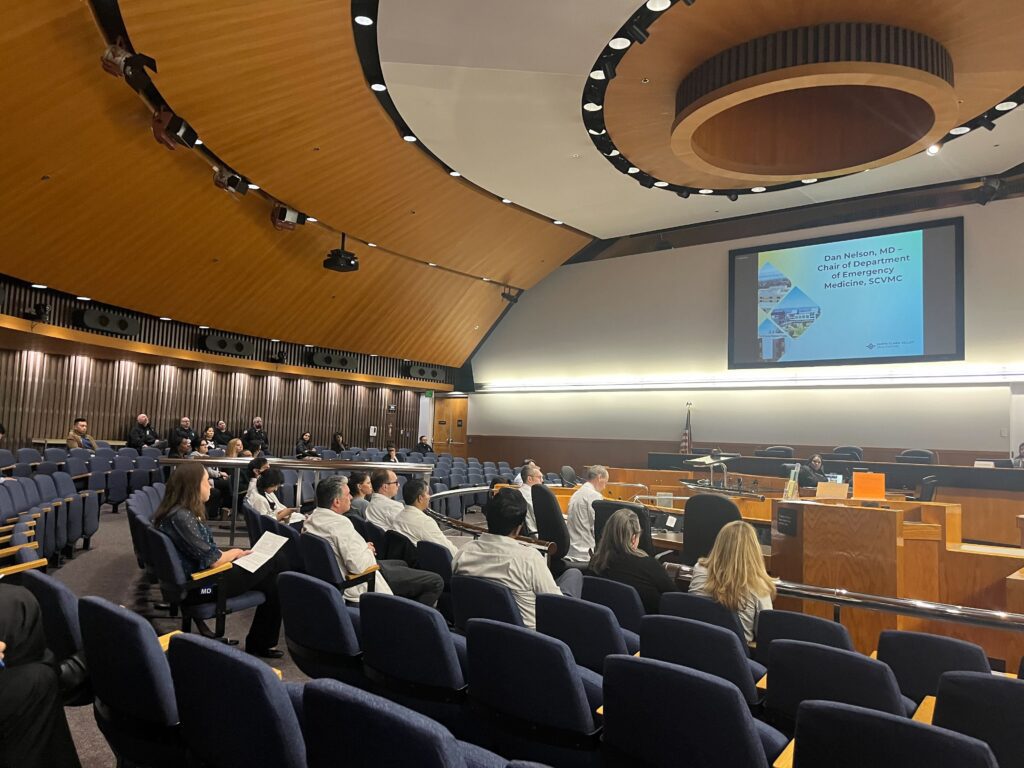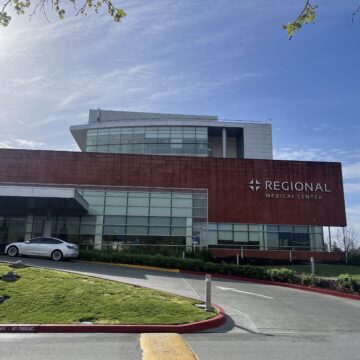The closure of East San Jose’s only trauma center puts the entire Santa Clara County public hospital system in jeopardy and threatens the survival of east side residents suffering a heart attack, stroke or other catastrophic medical event.
That was the unequivocal warning from county doctors at an emergency hearing on Wednesday. The hearing before the county Emergency Medical Services Agency comes more than a month after Regional Medical Center — owned by the company HCA Healthcare — announced plans to close its trauma, stroke and heart attack services by Aug. 12, citing financial strain.
County doctors said the closures could cause a 70% surge in trauma patients, or about 2,600 cases per year, being admitted to the ill-equipped and under-resourced Santa Clara Valley Medical Center (VMC) eight miles away. They fear the closure could break the county medical system.
“The proposed closures are unlike anything I can remember,” Dan Nelson, chair of Valley Medical Center’s Emergency Medicine Department, said at Wednesday’s hearing. “Working in a major urban emergency department without OBGYN, GI, interventional cardiology, comprehensive stroke services, trauma and neurology is utterly dystopian.”
Nelson and other hospital department leaders said the closures will disproportionately affect the county’s most vulnerable residents. That includes those without insurance who already rely on the county’s hospital system, which has endured years of scrutiny over worker shortages, outdated equipment and months long waits for crucial scanning and diagnoses at VMC.
Yet only a few residents showed up on Wednesday to hear these warnings.
“I guess I’m the only one from the community here,” East San Jose resident Edgar Pimentel said at the hearing. “I don’t think the community knows what’s really going on. I think there would be a lot more people here if they did. Closing down those services — it will be crazy for everybody.”

Time saves lives
Regional sits at the intersections of Highways 101, 680 and 280, and is one of only three trauma centers in Santa Clara County — Stanford University Medical Center and Valley Medical Center in San Jose are the other two. But doctors at the hearing said most patients in the county will go to VMC because it’s the closest.
District 5 San Jose Councilmember Peter Ortiz, who represents where Regional is located, said his mother who recently had a heart attack wouldn’t have survived had she been forced to make what could have been a 22-minute ambulance trip to VMC.
There’s been a lack of communication to the community regarding Regional’s service reductions, Ortiz said, but residents are starting to mobilize and plan to attend the Santa Clara County Board of Supervisors meeting on April 16 to speak on the issue.
“I have deep concerns about how this will impact the residents of East San Jose, as many of our residents have chronic health conditions like diabetes and high blood pressure and likewise struggle to acquire health coverage,” Ortiz told San José Spotlight.
HCA has a reputation for placing profits over patients. In San Jose the multibillion-dollar corporation has been systematically closing services that rely too heavily on Medicare and Medi-Cal patients due to lower profit margins. In 2004, HCA closed San Jose Medical Center, the city’s only downtown hospital. In 2020, the corporation shut down the maternity ward at Regional Medical Center, which had an immediate effect on East San Jose residents. In 2023, HCA shuttered its acute care psychiatrist services and neonatal intensive care unit at Good Samaritan Hospital in San Jose.
Limited options
Nelson said two other hospitals in the county system, O’Connor and St. Louise, rely on Regional to take patients requiring specialized medical care that they can’t provide.
“With Regional unable to accept those patients — and conversely contributing to demand — patients may be stranded without access to care for even longer periods,” Nelson said. “This will also result in more ambulances being called for more emergency facility transport.”
Praveen Anchala, chair of the radiology department at VMC, said CTs, MRIs and X-rays are already running at full capacity at the hospital 24/7, and are unable to fit more patients into the radiology system. Expanding their capacity requires space, money and time — none of which can happen in less than six months without a serious county response.
“The volume influx we are expecting to see can’t be overstated,” Anchala said at the hearing. “The numbers we have seen are pretty staggering.”
Nannette Logan, chief operating officer at Regional Medical Center, blamed the service reductions on lower patient volume, increased resource demands and increased regulatory requirements.
“We understand these changes may have an impact and in some cases may even be difficult,” Logan said at the hearing. “However we encourage those who speak today to please recognize that we’re making these changes so we can continue to care for our community’s health and sustainability for the long term.”
Regional is facing the same challenges as the county hospital system in retaining medical workers without breaking the bank to compete with wages offered by other private hospitals, according to Regional Trauma Medical Director Richard Kline.
“This is not a choice that anyone wants to make and if there is a way to change this, if anyone has ideas, come up and open the dialogue,” Kline said at the hearing.





